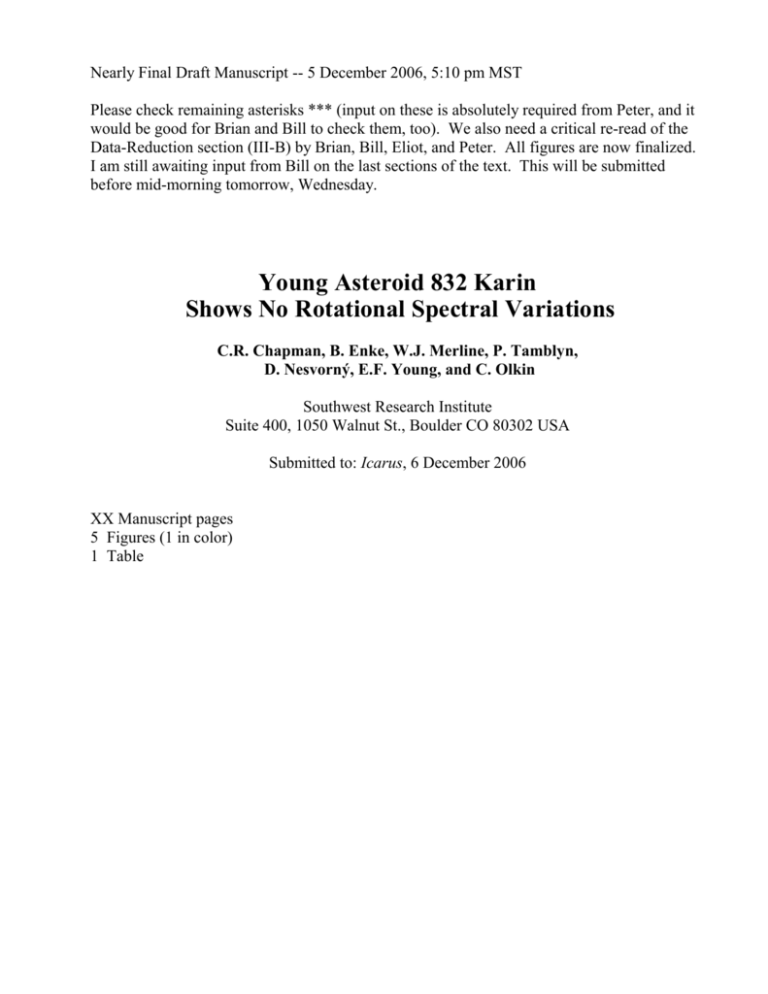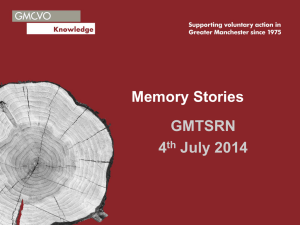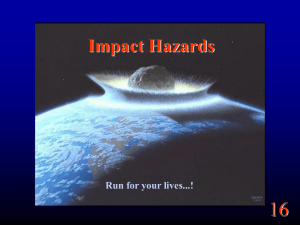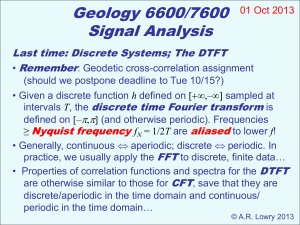karart06
advertisement

Nearly Final Draft Manuscript -- 5 December 2006, 5:10 pm MST Please check remaining asterisks *** (input on these is absolutely required from Peter, and it would be good for Brian and Bill to check them, too). We also need a critical re-read of the Data-Reduction section (III-B) by Brian, Bill, Eliot, and Peter. All figures are now finalized. I am still awaiting input from Bill on the last sections of the text. This will be submitted before mid-morning tomorrow, Wednesday. Young Asteroid 832 Karin Shows No Rotational Spectral Variations C.R. Chapman, B. Enke, W.J. Merline, P. Tamblyn, D. Nesvorný, E.F. Young, and C. Olkin Southwest Research Institute Suite 400, 1050 Walnut St., Boulder CO 80302 USA Submitted to: Icarus, 6 December 2006 XX Manuscript pages 5 Figures (1 in color) 1 Table Running Head: 832 Karin Shows No Rotational Spectral Variations Editorial Correspondence and Proofs: Dr. Clark R. Chapman Dept. of Space Studies Southwest Research Institute, Suite 400 1050 Walnut St. Boulder CO 80302 Tel.: (303) 546-9670 Fax: (303) 546-9687 Email: cchapman@boulder.swri.edu 2 Abstract We have made near-IR spectral observations of the very young (5.75 My) S-type asteroid 832 Karin, well sampled in rotational phase over its 18.3 h period. We find no significant variations in its reflectance spectrum. Karin is the brightest member of the Karin cluster (a sub-family of the larger, older Koronis dynamical family), which was shown to be exceptionally young by Nesvorný et al. (2002), using backward numerical integration of the orbital elements of cluster members. Their precise dating of the collisional breakup event gives us an opportunity, for the first time and without age dating of physical samples, to monitor time-evolution of processes, such as space weathering, that operate on timescales of ~1-10 My. Sasaki et al. (2004, 2005) had made similar measurements of Karin, although more sparsely sampled than ours, and claimed dramatically different colors as a function of rotational phase. Sasaki et al. interpreted their data to be showing the reddish, space-weathered exterior surface of the precursor asteroid, as well as an interior face, which had not had time to become space-weathered. On five nights over 2006 January 7-14 UT, we observed Karin with the SpeX (0.8-2.5 µm) instrument of the IRTF. We have analyzed data in both 30 and 60 intervals of rotational longitude, some of which we sampled on two different nights. The spectra from each of the longitude bins is consistent with little or no spectral variation as the asteroid rotates; certainly there are no changes as large as previously reported. It is likely that the previous observations were spurious. Our average spectrum is similar to the "blue" spectrum of Sasaki et al., which they interpreted to be the "fresh" surface. Karin is not quite as red as typical S-types, yet has rather shallow absorption bands. We surmise that the space-weathering process affecting Karin has had time to reduce spectral contrast, but has not operated long enough to redden its spectrum -- an intermediate case of space weathering, which has gone to completion for most main-belt asteroids. This work sets an important constraint on the timescale for the ubiquitous space-weathering process affecting S-types, namely that its effects are evident, but not yet complete, at ~6 My. Keywords: Asteroids, Asteroid Families, Asteroid Surface Compositions, Infrared Reflectance Spectra, Space Weathering 3 I. INTRODUCTION A long standing issue in asteroid astronomy concerns the degree to which asteroids exhibit changing colors as they rotate. A related issue concerns the degree of color variation among members of asteroid families. There are two main reasons for interest in such variations: (a) compositional differentiation processes and (b) space weathering processes. First, the observed variety of meteorites demonstrates the existence of many differentiated parent bodies, in which various minerals (within the presumably asteroidal precursor bodies) were spatially segregated as a result of prior heating and melting. Later, once these bodies have cooled and subsequently have broken into fragments during an energetic collision (catastrophic disruption), one can readily imagine that various fragments might have different mineralogies and that individual fragments might have different mineralogies on different sides. Discovery of such differences could provide insight concerning the interiors of differentiated bodies as well as the mechanics of asteroid collisions. The second reason to study color variations involves space weathering (cf. Chapman 2004). This is the process, due to one or more hypothesized mechanisms such as solar-wind and micrometeoritic bombardment of surfaces of airless bodies, that modifies, with increasing exposure to space, the inherent spectral characteristics of the constituent rocks. Space weathering partially masks and confuses interpretation of reflectance spectra in terms of mineralogy and meteoritic analogs. However, for family members derived from a recent catastrophic break-up, it is possible that some will exhibit the space-weathered exterior of the parent body, while others might be "fresh" or only partially space-weathered fragments of the body's interior. And, as with the differentiated case discussed above, it is possible that an individual fragment might show the space-weathered exterior color on one side, and the less space-weathered interior color on its opposite side. This paper addresses the issue of a single asteroid exhibiting diverse spectral properties on different sides. Recently, theoretical understanding of the dynamical evolution of a cluster of asteroids within the large Koronis family has presented an excellent opportunity to study space weathering attributes of members of a very young family. Nesvorný et al. (2002, updated by Nesvorný & Bottke, 2004) demonstrated that this small family-within-a-family, named the "Karin cluster," was formed by catastrophic collision just 5.75 ±0.05 My ago (discussed further below), less than 0.2% the age of the solar system. We have been observing some of the ~90 members of this family, and especially its largest and brightest member, 832 Karin. A principal goal is to determine the degree of space weathering that has developed within less than 6 My, and thus measure the absolute rate of space-weathering processes in the asteroid belt. Published estimates of space-weathering rates range from tens-of-thousands to hundreds-of-millions of years. 4 Although space weathering processes may affect the surfaces of all asteroids, most discussion of space weathering over the last three decades has concerned its effects on S-type asteroids, which is the broad taxonomic class of the Koronis and Karin members. The primary effects on 0.8 - 2.5 µm spectra of S-types are (1) a generalized reddening of the spectral slope and (2) diminished depth of the strong spectral bands of silicates (i.e. diminished spectral contrast, which is sometimes associated with lowered albedo). Thus this study focuses on central issues in the space weathering debates. Sasaki et al. (2004, 2005) claimed to have discovered major infrared color changes of Karin during an approximately one-hour period on 14 September 2003, using a spectrograph on the Subaru telescope. They interpreted the observations in terms of preservation of a space-weathered, S-type surface on one side of Karin, and a less-space-weathered, ordinary chondritic surface on the other side. Because Karin rotated less than 20 between the two very different spectra, it is difficult to formulate a shape, illumination geometry, and observing geometry that would permit such drastic spectral changes to occur. Thus we undertook to confirm this claim, which is the biggest regional color difference ever reported for an asteroid. In this paper, we describe our observing campaign on Karin during January 2006 using the SpeX spectrograph (Rayner et al. 2003) on the 3-m IRTF (NASA Infrared Telescope Facility on Mauna Kea, Hawaii), during which we measured Karin's reflectance spectrum from 0.8 - 2.5 µm, the same spectral range observed by Sasaki et al. We find no significant color variation as Karin rotates. In an accompanying paper in this journal, submitted simultaneously with ours, Vernazza et al. (2007) report independent visible and infrared observations of Karin and also find no significant rotational color variations. We begin by providing background discussions of rotational color variations on asteroids, the recent discovery of demonstrably young asteroid families, and summarize the Sasaki et al. result. Then we describe our observations and reductions in some detail, because this is the first publication from our new IRTF SpeX observing program on dynamically young asteroids, which commenced in 2005. We present our final results concerning Karin's virtual lack of rotational color changes. Finally, we assess and discuss the evidence concerning the reflectance spectrum of Karin. II. BACKGROUND A. Color Variations A century ago, asteroids were considered to be grey reflectors of sunlight and were occasionally used as solar standards. Bobrovnikoff (1929) undertook the first serious effort to study asteroid colors using a spectrograph on the Lick Observatory 36-inch refractor. Among his results, which seems all the more remarkable today (since it remains the best example), 5 was his discovery of spectral variations, with time, of 4 Vesta. Indeed, Bobrovnikoff used the color variations to determine the rotation period of Vesta, to fair accuracy. This result was subsequently overlooked as observers debated whether Vesta had a 5h or 10h rotation period, a question not settled until around 1980. Vesta's color variations are correlated with heterogeneity of Vesta's mineralogy (Gaffey 1997). There have been attempts over the years (e.g. Degewij et al. 1979) to detect albedo and/or color variations with rotation for some brighter asteroids observed with high photometric or polarimetric signal-to-noise. While real variations have been detected on a few asteroids (6 Hebe, 8 Flora, 44 Nysa, and 349 Dembowska, for example), generally at the level of a few percent, Vesta has remained the principal confirmed case for substantial color variation. One prominent case of reported spectral differences on opposite sides of an asteroid was for 433 Eros (Murchie & Pieters 1996), who interpreted the differences in terms of significant mineralogical variation across the face of Eros. While the NEAR Shoemaker mission to Eros did reveal statistically significant infrared color variations on Eros (Murchie et al. 2002), the main news was how colorimetrically uniform Eros is; the detected color variations were smaller than the differences inferred from telescopic spectra, which now must be considered as reflecting inherent uncertainties in the telescopic data. One early explanation for the uniformity of asteroid albedos and colors was that asteroids "painted themselves grey" (or whatever color) with ejecta from large cratering events, enabling localized material to be draped around the entire body due to low gravity on asteroids. While it is true that ejecta travel farther on asteroids than on bodies like the Moon, it is now understood that ejecta velocities are lower than had been thought and total homogenization is not expected. Spacecraft studies of individual asteroids have revealed significant localized non-uniformities in color and spectral traits (cf. Veverka et al. 1996 and Chapman 1996 for Ida, Abe et al. 2006 for Itokawa). However, even though the localized spectral differences can be large, the spots are often rather small and would yield very modest differences when observed in whole-disk (hemispheric) averages as is done in telescopic observations. B. Young Asteroid Families It has been learned over the past decade that asteroid families, produced by catastrophic inter-asteroidal collisions, gradually evolve in various ways. Original families diffuse, with some orbital elements changing on rapid timescales and others on longer timescales, due to resonances, the Yarkovsky Effect, and other forces, so that the original configuration is gradually lost. Other properties of individual family members also evolve with time, including spin state and surface properties. A recent discovery has permitted the identification of several very young asteroid families, which allows us to observe the postcollisional properties of such a break-up before the original conditions have had time to evolve very much. The first case involved identification and analysis of the Karin cluster within the Koronis family (Nesvorný et al. 2002). The cluster is apparently the product of a 6 moderate-sized (32 ±3 km diameter [Nesvorny et al., 2006]) Koronis family member that was disrupted only 5.75 ±0.05 My ago (Nesvorný & Bottke 2004). Nesvorný et al. (2002) applied the Hierarchical Clustering Method (Zappalà et al. 1994) to a new, state-of-the-art proper-element database (***Kne_evi_ & Milani 2003) to search for compact families with just 1/10th of the typical dispersion in orbit-element values of most families. They found a prominent, compact cluster of 39 asteroids (including Karin) within the Koronis family (the number known now is ~90); its orbital distribution is diagonal in proper semimajor axis vs. proper eccentricity and fits inside a similarly shaped "equivelocity" ellipse expected for a collisional dispersal of fragments. Simulations match the ellipse if the precursor body was near its perihelion when a catastrophic collision and break-up occurred, launching fragments away at ~15 m s-1. Cluster fragments then circled the Sun as a group. But within ~1000 years, they drifted away from each other around their nearly common orbits. Over longer durations, their orbital orientations (longitude of ascending node, argument of perihelion) also drifted apart, around 360, due to planetary perturbations. After only a few million years, the once-clustered asteroids had dispersed into a torus around the Sun, like the IRAS dust bands. By numerically integrating the orbits back in time to an instant when all the orbital elements are clustered, Nesvorný et al. (2002) found the absolute time when the Karin cluster formed: ~5.8 My ago (the timing is now dated to better precision, 5.75 ±0.05 My ago [Nesvorný & Bottke 2004]). (The chance that such a convergence could happen by happenstance during the full age of the solar system is <10-6!) This first-ever dated event must not be confused with the event that created the Koronis family. The age of the Koronis family, based on cratering studies of Ida (a Koronis member) and collisional/dynamical evolution studies, is 2-3 Gy (Chapman 2002, Marzari et al. 1995, Bottke et al. 2001), more than 400 times older than the Karin-cluster event, which is a very recent secondary disruption of an asteroid within the Koronis family. A number of other very young families and clusters have been identified subsequently, using similar approaches. Meanwhile, the Karin cluster has been considered a prime group for telescopic study. In the last few years, additional members of the family have been discovered (Nesvorný & Bottke 2004), but most of them are very faint. We have observed a number of Karin family members in our overall program (which includes lightcurves, thermal observations, colors, spectra, satellite searches, and other studies), but we concentrate here on the largest and brightest member of the family, 832 Karin itself, which is our most complete data set. C. Sasaki et al. Results for Karin In Fig. 1 we reproduce the chief result of Sasaki et al. (2004) concerning color variations on Karin. The upper data points ("first set") are data taken between UT 7:57 and 8:30 on 14 Sept. 2003, while the lower set of points ("third set") are data taken between UT 10:45 and 11:39. Another set of data ("second set"), which closely resembles the third set, was taken between UT 8:46 and 9:18. The first set of data yields an unusually reddish 7 spectrum, dramatically different from the other two sets. From lightcurve photometry taken near the same epoch (Yoshida et al. 2004), Sasaki et al. show that the first two data sets (which differ dramatically) were taken near average brightness of Karin as it was brightening about 0.1 mag. per hour. The third data set was taken near the lightcurve maximum. Sasaki et al. interpret the data as reflecting a mature space-weathered surface (first set) and fresh, largely un-weathered surfaces (second and third sets), although they do not rule out the possibility that the different colors instead reflect different mineralogies from within a differentiated precursor body. We discuss these data further when we compare them with our own results, in Sect. IV below. III. OUR OBSERVATIONAL PROGRAM A. Observational Procedure As part of our spectral studies of members of young dynamical families, using the SpeX spectrometer on the IRTF, we decided to concentrate on Karin during clustered nights of two separate observing runs in January 2006. We obtained good infrared spectra on 5 halfnights during an 8-night span, as shown in Table 1. The tabulated sky quality is a qualitative estimate from our logged notes as well as sky probe records obtained from the nearby CFHT site on Mauna Kea. Seeing was generally good on all nights, typically 0.6 arcsec. During all nights we observed remotely from our Boulder, Colorado, offices, but one of us (EFY) was also present onsite at the IRTF on the last two nights. SpeX was used in its low-resolution prism mode, with the 0.8 x 60 arcsec slit. Both automated and hand-guiding were used to center the object in the slit due to minor deviations from tracking at the asteroid rate. Observations consisted of 4 sets of 60-sec. integrations in ABBA sequence (A and B are beam offset positions in the slit). Usual procedures were used to ensure good focus and orientation of the slit at the parallactic angle. Four to six sets of standard star observations were obtained during each half-night, both for determination of atmospheric extinction and as solar analogs used to derive spectral reflectances. (Our chief standard star was HD95868, G2V, V=9.7; we also observed HD89269, G5, V=7.5, and HD28099 [Hyades 64], G2V, V=8.1.) Using the SpeX CAL-PRISM macro, arc-lamp spectral calibrations were obtained about 10 times per half-night in addition to a flat-field calibration. B. Data Reduction We describe below a data reduction pipeline that we have used to reduce our data and derive reflectance spectra for Karin. These procedures replicate standard procedures for astronomical spectrophotometry and employ algorithms we and others have previously used to reduce prism-mode SpeX data. In addition, we have checked critical elements of our data 8 reduction against independent algorithms from IRAF and S.J. Bus, as we briefly describe below. The first step is to apply flat-field corrections, which includes removal of a large thermal gradient due to the quartz flat-field lamp. Bad pixels are identified as out-of-bounds pixels in the flat fields; these are not included in the eventual spectral extraction. Next we rectify the raw 512 x 512 pixel CCD images; the slight curvature is corrected using 10 arclamp spectral lines of known wavelength. We then perform a wavelength calibration by fitting the 10 arc-lamp spectral lines, ranging between 0.811 and 2.51 µm, with a 4th-order polynomial. The AB or BA pairs are differenced to remove the bias, dark current, and as a first order sky subtraction. The center of the spectral trace is identified from a gaussian fit to the exposure after it has been summed over all wavelengths. Finally, the residual sky (variable OH lines are typically the worst residuals) is subtracted from each AB pair, using means within rectangles to the left and right of the spectral traces (and avoiding any background stars in the slit). We extract the trace flux vs. wavelength using data within a rectangular box, centered on the central row, with a width equaling 4 times the calculated FWHM of the integrated trace. Bad pixels are excluded from the summation. (We have made spot comparisons of our results with optimally weighted extraction routines, including one in IRAF. The noise is somewhat greater for our rectangular extractions, but this is only a minor problem for the relatively bright target Karin. Most important, there are no systematic differences between the extraction procedures.) Each of the ~400 spectral traces is assigned a weight based on inherent attributes of the data and on notes in our observing log. Data that may have been affected by cirrus clouds, guiding errors, proximity of background stars, difficulties in background subtraction, etc. are downweighted or omitted from our final results. Extinction corrections are determined from observations of our prime star over the widest airmass range, with some modifications (especially for the 12 Jan. data) to avoid data affected by cirrus and to include observations closer in time to the relevant observations of Karin. Generally, our nights were stable enough so that extinction corrections derived in this fashion should be more than adequate. However, we have also performed spot calculations using, in an unweighted fashion, the approach of S.J. Bus (personal comm. 2006); that approach uses the inherent water absorption bands in the asteroid spectra and the known airmass at the time of an observation to compute a water vapor model and correct to zero water vapor and zero airmass [***Peter: is this the correct description?]. These comparisons suggest that our results based on calculated extinction coefficients are generally accurate to within ___%*** except on 12 Jan. when they should be accurate to within ___%***. Resulting spectra for all 104 ABBA observations are then smoothed using a running boxcar of 5 pixels or Δλ = 0.017 µm. These spectral observations are distributed over rotational phase, adopting the 18.35 h rotation period for Karin, as shown in Fig. 2. We have averaged all spectra in six bins of rotational longitude, each 60 wide, to search for significant 9 spectral differences with rotational phase; these average spectra are presented in Fig. 3. In Fig. 4, we present 12 spectra, for each 30 longitude interval; these spectra are noisier, of course, especially longward of 1.5 µm, but they reveal spectral constancy near the 1 µm band over smaller changes in rotational longitude. All spectra are normalized to unity at 1.0 µm and vertically offset from each other by 0.15. Error bars are shown for the noisiest and least noisy averages, in both Figs. 3 and 4; they are standard deviations derived from variability within the 5 pixel smoothing interval but do not account for any systematic errors [*** is this description correct?]. IV. DISCUSSION AND CONCLUSIONS As can be seen in Figs. 3 and 4, there are minimal significant differences between the 6 or 12 average spectra. Relevant spectral parameters, such as overall slope, depth of the 1 µm absorption band, and center wavelength of the band appear nearly identical within the range of typical errors. Our spectral slopes may be slightly redder in the 180 - 210 and 300 330 intervals and least red in the 120 - 150 interval; but the maximum slope difference we see is less than 1/6th that reported by Sasaki et al. (2004; see Fig. 1). We now address the question of whether our results could possibly be compatible with the Sasaki et al. results due to different sun-Earth-Karin geometry. First, we note that we are not (yet) able to determine the rotational phase of our observations with respect to the rotational phases observed 2½ years earlier by Sasaki et al., due to imprecision in the known rotation period of Karin, although this should be possible in the future. Second, the pole of rotation of Karin is not yet known. So conceivably a very reddish large spot on Karin, responsible for the reddish spectrum of Sasaki et al., was located on the opposite hemisphere of Karin when we observed. Such a spot could not be located at or near a pole, however, because the Sasaki et al. observations were made at the same epoch that Yoshida et al. (2004) observed a lightcurve for Karin with an amplitude exceeding 0.6 mag., which suggests a more nearly equatorial presentation in late 2003. We do not have simultaneous lightcurve photometry and our slit spectroscopy techniques are not suitable for deriving a lightcurve, so we cannot rule out that we were observing pole-on and that the hypothesized spot was at moderate latitudes on the hidden hemisphere. We believe that this is not the case, however, since our observations were made about one-half of a Karin revolution period after the Sasaki et al. observations, so we were observing toward ecliptic longitudes very roughly 180 different from the geometry in late 2003; pole-on geometries, if Karin has a high obliquity, would be closer to 90 and 270 longitude differences from the Sasaki et al. geometry and from our own. Moreover, any spot that could be responsible for the enormous differences seen in Fig. 1 would have to be very large, and it seems very unlikely that it could have been completely hidden from our view. In fact, it is already difficult to imagine a natural shape of Karin, and shape and size of a reddish spot, that would permit the large color differences reported by Sasaki et al. in less 10 than 20 of rotational phase. Indeed, the last integration of the Sasaki et al. "first set" (with reddish colors) and the first integration of the "second set" (with normal colors) are reported to be only 16 min. apart, during which Karin rotated only 5. So there would have to be some blending of the two different spectral traits; hence the hypothesized spot would be required to have even more extreme colors than shown by the reddish spectrum. In summary, the original differences reported by Sasaki et al. were already difficult to understand. Now that we have observed throughout a Karin rotation period and found only minimal spectral variations at most, we think it is reasonable to regard the reported color changes as disproved and to regard the reddish Sasaki et al. spectrum as spurious. We cannot speculate about what went wrong, not being familiar with the details of the instrument and observing procedures. In Fig. 5, we present the average reflectance spectrum of 832 Karin from our observations in January 2006, weighted with the same weights for each trace based on sky quality, guiding, etc. as applied in Figs. 3 and 4. Our spectrum closely resembles previously published spectra of Karin (cf. Vernazza et al. 2006). A comparison of our spectrum with Fig. 1 shows that it is similar, but not identical, to the third-set spectrum of Sasaki et al. (the lower spectrum in Fig. 1). In fact, our spectrum is slightly less red than the Sasaki et al. spectrum and exhibits a slightly deeper 1 µm absorption band. (Even our reddest longitudes, 180 - 210 and 300 - 330, are very slightly less red than the third-set Sasaki et al. spectrum.) These modest differences could result from (a) different phase angles (although we observed at larger phase angles than Sasaki et al., which often results in slightly reddened spectra), (b) from modestly different systematic errors in data reduction, which are normally encountered, or (c) a slight slope difference between our prime G2V standard star, or the G2V star used by Sasaki et al., and the Sun. Thus we can regard the second and third sets of Sasaki et al. as representing approximately the true infrared spectral traits of Karin, with the first set being spurious. During 2005 and 2006, we have observed other Karin cluster members, as well as other members of the Koronis and other asteroid families, using the same observing procedures with SpeX. We are not yet at the stage of data reduction to thoroughly compare our Karin spectrum with our other results, but we can make a few general statements. We agree with others [e.g. Vernazza et al. 2006] who have previously reported that Karin is slightly less red, in this spectral region, than other S-types. The depths of Karin's absorption bands also seem slightly weaker than other S-types and much weaker than for meteoritic analogs like ordinary chondrites. We surmise that Karin, as a very young asteroid, has undergone sufficient space weathering to reduce the spectral contrast of its inherent minerals but that there has been insufficient time to redden its spectrum to the degree exhibited by older S-types. Thus the space weathering processes have only approached intermediate maturity in ~6 My. 11 Acknowledgements. Our work has been supported by the NASA Planetary Astronomy program (grant #NNG04GI45G). We thank Bobby Bus and the staff of the IRTF for their efforts to make these remote-site observing runs successful and for discussion of data reduction procedures. Observations were obtained during E.F. Young's young-asteroids SpeX program and time converted to SpeX (through the generosity of A. Tokunaga and the IRTF TAC) from W.J. Merline's AO program when the AO proved not to be available. We were Visiting Astronomers at the Infrared Telescope Facility, which is operated by the University of Hawaii under Cooperative Agreement no. NCC 5-538 with the National Aeronautics and Space Administration, Science Mission Directorate, Planetary Astronomy Program. REFERENCES Abe, M., Takagi, Y., Kitazato, K., Abe, S., Hiroi, T., Vilas, F., Clark, B.E., Abell, P.A., Lederer, S.M., Jarvis, K.S., Nimura, T., Ueda, Y., Fujiwara, A. 2006. Near-infrared spectral results of asteroid Itokawa from the Hayabusa spacecraft. Science 312, 1334-1338. Bobrovnikoff, N.T. 1929. The spectra of minor planets. Lick Observatory Bulletin, No. 407, 14, 18-27. ***Bottke, W.F., Vokrouhlichý, D., Bro_, M., Nesvorný, D., Morbidelli, A. 2001. Dynamical spreading of asteroid families by the Yarkovsky effect. Science 294, 1693-1696. Chapman, C.R. 1996. S-type asteroids, ordinary chondrite, and space weathering: The evidence from Galileo's fly-bys of Gaspra and Ida. Meteoritics & Planet. Sci. 31, 299-725. Chapman, C.R. 2002. Cratering on asteroids from Galileo and NEAR Shoemaker. In: Bottke, W., Cellino, A., Paolicchi, P., Binzel, R. (Eds.), Asteroids III, Univ. Arizona Press, Tucson, pp. 619-631. Chapman, C.R. 2004. Space weathering of asteroid surfaces. Annu. Rev. Earth Planet. Sci. 32, 539-567. Degewij, J., Tedesco, E.F., Zellner, B. 1979. Albedo and color contrasts on asteroid surfaces. Icarus 40, 364-374. Gaffey, M.J. 1997. Surface lithologic heterogeneity of asteroid 4 Vesta. Icarus 127, 130-157. ***Kne_evi_, Z., Milani, A. 2003. Proper element catalogs and asteroid families. Astron. & Astrophys. 403, 1165-1173 (see also http://hamilton.dm.unipi.it/cgi-bin/astdys/astibo). 12 Marzari, F., Davis, D., Vanzani, V. 1995. Collisional evolution of asteroid families. Icarus 113, 168-187. Murchie, S.L., Pieters, C.M. 1996. Spectral properties and rotational spectral heterogeneity of 433 Eros. J. Geophys. Res. 101, E2201-2214. Murchie, S., Robinson, M., Clark, B., Li, H., Thomas, P., Joseph, J., Bussey, B., Domingue, D., Veverka, J., Izenberg N., Chapman, C. 2002. Color variations on Eros from NEAR multispectral imaging. Icarus 155, 145-168. Nesvorný, D., Bottke, W.F., Dones, L., Levison, H. 2002. The recent breakup of an asteroid in the main-belt region. Nature 417, 720-722. Nesvorný, D., Bottke, W.F. 2004. Detection of the Yarkovsky effect for main-belt asteroids. Icarus 170, 324-342. Nesvorný, D., Enke, B.L., Bottke, W.F., Durda, D., Asphaug E., Richardson, D. 2006. Karin cluster formation by asteroid impact. Icarus 183, 296-311. Rayner, J.T., Toomey, D.W., Onaka, P.M., Denault, A.J., Stahlberger, W.E., Vacca, W.D., Cushing, M.C., Wang, S. 2003. SpeX: A medium-resolution 0.8-5.5 micron spectrograph and imager for the NASA Infrared Telescope Facility. P.A.S.P. 115, 362-382. Sasaki, T., Sasaki, S., Watanabe, J., Sekiguchi, T., Yoshida, F., Kawakita, H., Fuse, T., Takato, N., Dermawan, B., Ito, T. 2004. Mature and fresh surfaces on the newborn asteroid Karin. Astrophys. J. 615, L161-L164. Sasaki, T., Sasaki, S., Watanabe, J., Sekiguchi, T., Yoshida, F., Ito., T., Kawakita, H., Fuse, T., Takato, N., Dermawan, B. 2005. Difference in degree of space weathering on the newborn asteroid Karin. Lunar Planet. Sci. XXXVI, 1590.pdf. Vernazza, P., Birlan, M., Rossi, A., Dotto, E., Nesvorny, D., Brunetto, R., Fornasier, S., Fulchignoni, M., Renner, S. 2006. Physical characterization of the Karin family. Astron. & Astrophys., submitted (ms. aa5779-06). Vernazza, P. et al. 2007. Submitted to Icarus (this issue). Veverka, J., Helfenstein, P., Lee, P., Thomas, P., McEwen, A., Belton, M., Klaasen, K., Johnson, T.V., Granahan, J., Fanale, F., Geissler, P., Head, J.W. 1996. Ida and Dactyl: Spectral reflectance and color variations. Icarus 120, 66-76. 13 Yoshida, F., Dermawan, B., Ito, T., Sawabe, Y., Haji, M., Saito, R., Harai, M., Nakamura, T., Sato, Y., Yanagisawa, T., Malhotra, R. 2004. Photometric observations of a very young family-member asteroid (832) Karin. Publ. Astron. Soc. Japan 56, 1105-1113. Zappalà, V., Cellino, A., Farinella, P., Milani, A. 1994. Asteroid families II. Extension to unnumbered multiopposition asteroids. Astron. J. 107, 772-801. 14 TABLE 1. Date (UT) 2006-01-07 2006-01-08 2006-01-12 2006-01-13 2006-01-14 Start/End Times (UT) 11:52 11:20 11:43 11:32 11:28 - 15:29 15:29 15:34 15:29 15:20 Karin Spectral Data. No. (ABBA obs.) 15 21 23 29 16 15 Sky Quality excellent excellent fair very good good Figure Captions Fig. 1. Reported different IR reflectance spectra on Karin (reproduced in black-and-white from Sasaki et al. 2004). The relevant spectra are the small data points with error bars, which have been normalized to unity at 1.0 µm. The upper spectrum is the "first set" of data by Sasaki et al.; the bottom spectrum is the "third set" (which is very similar to the "second set"). Small squares and solid curve are comparison spectra, not discussed here. Fig. 2. Timings of our spectral observations of Karin, showing equivalent rotational phase, assuming a rotation period of 18.35 h. Individual points show time and longitudes for ABBA quartets or ABBAABBA octets. The chart demonstrates that our rotational coverage is good, with no gap >20 and over 80 covered on two different nights. Fig. 3. Average reflectance spectra for Karin in six different 60 bins of rotational longitude. Normalized to unity at 1.0 µm and shifted vertically by 0.15. Error bars are shown for the noisiest and cleanest average spectra. Fig. 4. Average reflectance spectra for Karin in 12 different 30 bins of rotational longitude. Normalized to unity at 1.0 µm and shifted vertically by 0.15. Error bars are shown for the noisiest and cleanest average spectra. Fig. 5. Weighted average reflectance spectrum for Karin from our five nights of data, normalized to unity at 1.0 µm. 16 Fig. 1: 17 Fig. 2: 18 Fig. 3: 19 Fig. 4: 20 Fig. 5: 21








